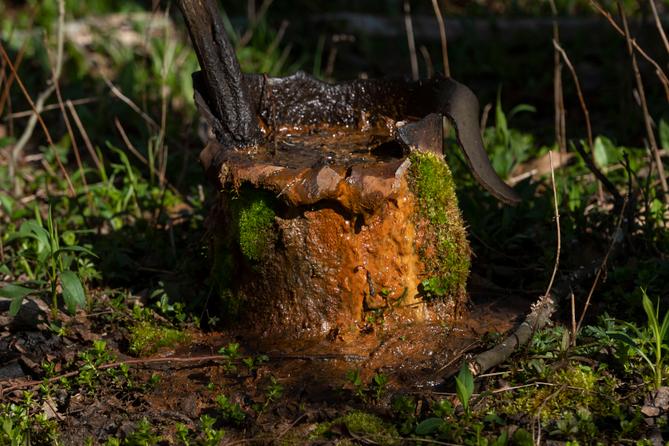Spotlight PA is an independent, nonpartisan, and nonprofit newsroom producing investigative and public-service journalism that holds power to account and drives positive change in Pennsylvania. Sign up for our free newsletters.
HARRISBURG — With the help of millions of dollars in federal funding, Pennsylvania has plugged more oil and gas wells in the last year and a half than it did in the past decade.
Environmental advocates say this marks enormous progress for a state that has long struggled with tens of thousands of dangerous wells that leak methane — a powerful greenhouse gas that fuels climate change — into the atmosphere.
But they also caution that the unprecedented amount of money flowing into Pennsylvania may not be going toward the worst wells, and they argue the plugging project needs better oversight.
Take, for example, the Pennsylvania Department of Environmental Protection’s decision to plug wells on Gerry Schimp’s McKean County land last February.
Schimp didn’t ask for the wells on his property to be plugged, but the state came knocking. The wells were drilled before Schimp acquired the property, and the state was unable to determine the last known operator that would have been responsible for plugging them.
Workers hired by the DEP spent about two months plugging 13 wells on the land, but Schimp said about half of the work they did was replugging already capped wellbores — the drilled holes used to extract oil or gas.
“They’ve done a good job, but they’ve plugged wells that didn’t need plugging,” said Schimp, a retiree who previously worked in the oil and gas industry.
Schimp’s wells were plugged as a result of a huge influx of federal funding from the 2021 Infrastructure Investment and Jobs Act.
The IIJA grants are intended to reduce the methane leakage generated by unplugged abandoned wells. These wells can also be hazardous to nearby residents, who can fall into open holes or be harmed by toxic fluids that seep into groundwater.
The program is slated to dole out more than $4 billion to well plugging efforts across the country, and Pennsylvania could receive as much as $400 million over the next decade. The money is supposed to target wells that are unproductive and have owners who either can’t be located or can’t afford to plug the holes themselves.
The commonwealth got its initial $25 million IIJA grant in August 2022.
In the decade before receiving IIJA funds, the DEP plugged 165 wells. Since the funds arrived, it has plugged over 100, and plans to plug around 100 more over the next two years.
But because of tight deadlines attached to the first batch of federal money, the DEP has focused most of its attention on quantity rather than targeting wells that are big polluters or that are dangerous to people, an agency official told Spotlight PA.
As the program moves into its next phase, environmentalists, landowners, and pluggers all have their own, diverging opinions about how the DEP should handle its federal windfall.
A disputed strategy
Even if Pennsylvania receives the full $400 million from the federal government, the money won’t be nearly enough to plug all of Pennsylvania’s old, leaky wells.
When the commonwealth first applied for federal assistance in 2021, it reported 26,908 unproductive wells whose owners couldn’t be located. Of the 26 states that applied for funding, that’s by far the most. The next highest, Ohio, estimated it had around 19,662.
The real number of abandoned wells likely exceeds that number. The DEP estimates that there could be over 300,000 in total, and some academics say the number could be as high as 750,000.
An analysis by Spotlight PA found that since IIJA money was first disbursed in 2022, the average cost of plugging a single well has been about $100,000. That puts a nearly $3 billion price tag on the cost of plugging all of the state’s documented abandoned oil and gas wells.
Kurt Klapkowski, the DEP’s oil and gas deputy secretary, said he wants to get a system in place before asking state lawmakers for more resources. “By demonstrating that success,” he said, “then we sort of earned the right to have that conversation going forward.”
Laurie Barr, co-founder of the environmental advocacy group Save Our Streams PA, said she worries that the wells that are being plugged are chiefly owned by industry insiders or people with knowledge of the energy industry, rather than the ones that are the most environmentally damaging.
“The squeaky wheels get the grease,” Barr said
She pointed to DEP data on the wells plugged with IIJA money. As of Feb. 23, the data showed that just 5% of plugged wells had a noted environmental impact and only 12% had a noted human impact.
Kelsey Krepps, a representative for the Sierra Club’s Beyond Dirty Fuels Campaign, echoed Barr’s comments, saying that while she’s largely supportive of how the DEP has used the initial $25 million, the environmental group is concerned that the department prioritized ease over health.
“While that's understandable, it's definitely not getting to the concerns of folks who have been living with these things for a very long time,” Krepps said.
Klapkowski acknowledged that the DEP has plugged a lot of wells that weren’t particularly high emitters. But he said the strategy stems from the constraints that came with federal dollars.
Once Pennsylvania received its initial $25 million from the IIJA, it had only 90 days to decide where almost all of it would be used.
Given that tight turnaround, Klapkowski said the DEP wanted to plug as many wells as possible, as fast as possible. It identified “anchor wells” — high emitters already known to the DEP as problems and relatively easy to access — and focused on those, also targeting the wells that surround the anchor to maximize cost efficiency.
Using that strategy, the DEP was able to commit $24.8 million of the initial grant by the federal deadline. So far, a little less than half of the money has gone to contractors for completed work.
Another concern that environmental groups have about the federal funds is that some of the wells that get plugged may not technically be eligible because they have identifiable owners.
Krepps pointed to a DEP spreadsheet, obtained through a Right-to-Know request by the Sierra Club and shared with Spotlight PA, that shows operator names for thousands of wells. Those wells’ owners should still be responsible for plugging them.
According to Krepps, the DEP told the Sierra Club that if a well's owner can be identified, the agency will force them to pay back the cost of the plugging. Krepps said the Sierra Club plans to track payments on such wells.
A report issued by the Wolf administration backed up Krepps’ concerns, finding that the conventional oil and gas industry has a “culture of non-compliance” that leads to improperly abandoned becoming the responsibility of the state.
Klapkowski said he would rather order owners to address their leaky wells than spend federal funding. But with limited time, he said, his priority was to get the money out.
“With the initial grant, we did try to find projects that didn't involve things like building a road through a high-quality wetland or something like that,” said Klapkowski. “I think going forward, we have a little bit more flexibility.”
The DEP will have additional time to decide where federal money goes in the future because the rest of the grants it is eligible for come with different terms than the initial $25 million.
Also known as formula and performance grants, these additional funds, which together could bring Pennsylvania more than $350 million, would have a longer, five-year disbursement period and reward the DEP for plugging wells with higher methane emissions.
The formula grant presents the largest sum available to Pennsylvania, at $305 million. Performance grants are smaller and doled out based on how the state uses the funds. For example, if Pennsylvania strengthens its plugging standards, it could receive up to $20 million.
Preparing for future funds
Having additional time to dole out funds isn’t the only change Klapkowski sees for plugging wells in the future. The DEP, he said, is already trying to address many of the main concerns of environmental advocates.
Most of the federal money has to be used for plugging-related expenses, but 10% of the initial grant can go toward “administrative costs” like staff salaries. The DEP uses that money to hire more inspectors and expand the search and documentation of more wells.
The DEP is also reassessing how the department appraises wells.
Currently, the agency uses an internal scoring system to rate each well in terms of the hazard it poses. The system includes assessing the wellbore’s ecological and human impacts, as well as measuring the structural integrity of the well.
Klapkowski says the department is currently planning two major changes to that system: adding a new measure of methane levels, and considering environmental justice areas — specially designated tracts that have been impacted by energy development and are more vulnerable to the effects of climate change.
Other changes that could be coming have more to do with the niche, competitive market for plugging contracts in Pennsylvania.
The DEP doesn’t plug wells itself. It issues contracts that are then bid on by companies in and out of the state. These companies are preparing for the influx of new work that a decade of federal funding will bring by investing in equipment and hiring employees.
Luke Plants, owner of the Bradford-based plugging company Plants and Goodwin, said that he “purposefully scaled up in 2022 knowing that 2023 would be when the money hit the state bank account.”
Plants said his company has received roughly a quarter of the Pennsylvania work funded by federal grants, and he has thoughts on how the state can improve its process.
He wants the DEP to put together even larger contracts that would plug more wells, arguing that increasing the number of holes plugged per contract would also lower costs. Already, the number of wells plugged per contract has doubled since federal funding came along — a byproduct of the DEP using its “anchor well” approach.
Rob Kozel, the president of Keystone Wireline, another plugging company, also argued that bundling wells would be more efficient because it would allow “more time on location and less time between jobs.”
But not all pluggers feel the same way.
Klapkowski said he’s also heard from smaller companies that the department should issue contracts that bundle fewer wells — otherwise, pluggers will not be able to afford the bond costs that come with state contracts.
Some lawmakers are on those small pluggers’ side. State Rep. Martin Causer (R., McKean) said he thinks the DEP’s bureaucracy and high bonding costs prevent smaller plugging companies from bidding on contracts, and that this makes the whole enterprise less competitive.
“My focus is making sure that we plug the maximum number of wells with the [money] that we have. The bureaucracy is sort of weighing that down,” Causer said.
Klapowski said he considers all approaches to be on the table, from changing bonding costs to a program currently under development in which companies would front the cost to plug wells and then be reimbursed by the DEP.
Pennsylvania isn’t going to plug all of its wells anytime soon, he noted. He expects that decades from now, the DEP will still be finding and filling abandoned oil and gas wells.
But, he added, the promise of federal funds allows there to finally be a comprehensive plan.
The long-term goal, he said, is “to try to build the foundation for the program that's going to continue for the next 50 or 75 years. Because frankly, it is that size of a problem.”
BEFORE YOU GO… If you learned something from this article, pay it forward and contribute to Spotlight PA at spotlightpa.org/donate. Spotlight PA is funded by foundations and readers like you who are committed to accountability journalism that gets results.

